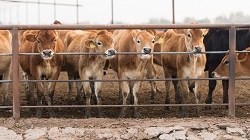
Whether you're new to the cattle ranch, or a seasoned veteran there is always a way to improve your fencing. Here are five best practices to use when installing cattle fences:
- Make sure corner posts are the right size.
One of the most common mistakes with cattle fencing is underestimating the length of corner posts. Corner posts should be set deep into the ground to maintain a good fencing structure. The depth in the ground should be equal to, or greater than, the height of the top wire. The diameter of the posts depends on the type of fencing used, and the strength of the fence. The smallest diameter for a light fence would be 1-2 inches, whereas a heavy fence may need a 7 or 8 inch diameter post.
To really make sure corner posts stay grounded, it's recommended that a bracing system be used, such as a floating diagonal bracing system, that will minimize movement in the corner posts.
- Use flexible post materials, like plastic or wood.
Steel posts may seem like the obvious choice due to steels’ strength, but it can be a mistake because steel posts increase the chances of power shortage in an electric fence. Wood or plastic are the best option as they are flexible, and put less strain on the fence's insulator.
- Fence posts should be spaced appropriately.
Many people think installing more posts will make the fence more stable, however, with cattle fencing that is not the case. With an electric fence, posts need to be further apart because it can decrease the effectiveness of the current. Post spacing should allow for 50 to 100 feet between each post.
- Space ground rods throughout the length of the fence.
When using electric fencing, ground rods are essential to the effectiveness and infrastructure of the fence. A good rule to follow is 3 feet of ground rods for each joule of energizer output. In terms of the joule output, it's recommended that 1 joule of output is used for 1 mile of fencing. So if your fence is 10 miles long, the joule output would be a 10-joule energizer. Therefore, a 10-joule energizer fence should use 30 feet of ground rods. For optimal use, place the ground rods throughout the entire fencing system because this will promote a steady current of electricity though the fence.
- Don’t try to keep wildlife out.
A flexible material is actually more effective when it comes to cattle fencing. Wildlife can damage the fence when trying to pass through, so instead try something more flexible. The flexibility will prevent animals from bending posts, thus decreasing maintenance on the fencing system.
When using these five tips, your cattle fence will be stronger than ever. When building your new fence, it's best to use an installation tool that is ideal for outdoor work. The BECK America F70G is cordless, and perfect for outdoor use. The nose design is ideal for fencing, and will make the process of installing a fence as painless as possible. If you prefer a pneumatic stapling system, there’s the F46A. It’s high power is ideal for hardwood applications like livestock fencing, both batten and high-tensile wire. It’s got good balance and a rubber grip for ease of handling. No matter what style of fence stapler you prefer, BECK America has you covered.
.svg.png)

